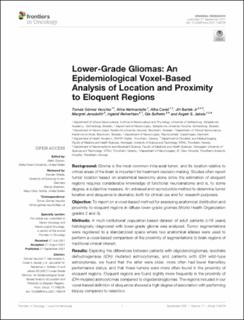| dc.contributor.author | Gómez Vecchio, Tomás | |
| dc.contributor.author | Neimantaite, Alice | |
| dc.contributor.author | Corell, Alba | |
| dc.contributor.author | Bartek, Jiri | |
| dc.contributor.author | Jensdottir, Margret | |
| dc.contributor.author | Reinertsen, Ingerid | |
| dc.contributor.author | Solheim, Ole | |
| dc.contributor.author | Jakola, Asgeir S. | |
| dc.date.accessioned | 2022-08-17T14:37:42Z | |
| dc.date.available | 2022-08-17T14:37:42Z | |
| dc.date.created | 2021-10-25T12:39:15Z | |
| dc.date.issued | 2021 | |
| dc.identifier.citation | Frontiers in Oncology. 2021, 11, 748229. | en_US |
| dc.identifier.issn | 2234-943X | |
| dc.identifier.uri | https://hdl.handle.net/11250/3012382 | |
| dc.description.abstract | Background:
Glioma is the most common intra-axial tumor, and its location relative to critical areas of the brain is important for treatment decision-making. Studies often report tumor location based on anatomical taxonomy alone since the estimation of eloquent regions requires considerable knowledge of functional neuroanatomy and is, to some degree, a subjective measure. An unbiased and reproducible method to determine tumor location and eloquence is desirable, both for clinical use and for research purposes.
Objective:
To report on a voxel-based method for assessing anatomical distribution and proximity to eloquent regions in diffuse lower-grade gliomas (World Health Organization grades 2 and 3).
Methods:
A multi-institutional population-based dataset of adult patients (≥18 years) histologically diagnosed with lower-grade glioma was analyzed. Tumor segmentations were registered to a standardized space where two anatomical atlases were used to perform a voxel-based comparison of the proximity of segmentations to brain regions of traditional clinical interest.
Results:
Exploring the differences between patients with oligodendrogliomas, isocitrate dehydrogenase (IDH) mutated astrocytomas, and patients with IDH wild-type astrocytomas, we found that the latter were older, more often had lower Karnofsky performance status, and that these tumors were more often found in the proximity of eloquent regions. Eloquent regions are found slightly more frequently in the proximity of IDH-mutated astrocytomas compared to oligodendrogliomas. The regions included in our voxel-based definition of eloquence showed a high degree of association with performing biopsy compared to resection.
Conclusion:
We present a simple, robust, unbiased, and clinically relevant method for assessing tumor location and eloquence in lower-grade gliomas. | en_US |
| dc.language.iso | eng | en_US |
| dc.publisher | Frontiers | en_US |
| dc.rights | Navngivelse 4.0 Internasjonal | * |
| dc.rights.uri | http://creativecommons.org/licenses/by/4.0/deed.no | * |
| dc.subject | Glioma grade 2 | en_US |
| dc.subject | Glioma grade 3 | en_US |
| dc.subject | Surgical oncology | en_US |
| dc.subject | Diagnostic imaging-methods | en_US |
| dc.subject | Magnetic resonance imaging-methods | en_US |
| dc.subject | Neurologic deficit | en_US |
| dc.title | Lower-Grade Gliomas: An Epidemiological Voxel-Based Analysis of Location and Proximity to Eloquent Regions | en_US |
| dc.type | Peer reviewed | en_US |
| dc.type | Journal article | en_US |
| dc.description.version | publishedVersion | en_US |
| dc.rights.holder | © 2021 Gómez Vecchio, Neimantaite, Corell, Bartek, Jensdottir, Reinertsen, Solheim and Jakola | en_US |
| dc.source.volume | 11 | en_US |
| dc.source.journal | Frontiers in Oncology | en_US |
| dc.identifier.doi | 10.3389/fonc.2021.748229 | |
| dc.identifier.cristin | 1948217 | |
| dc.source.articlenumber | 748229 | en_US |
| cristin.ispublished | true | |
| cristin.fulltext | original | |
| cristin.qualitycode | 1 | |

